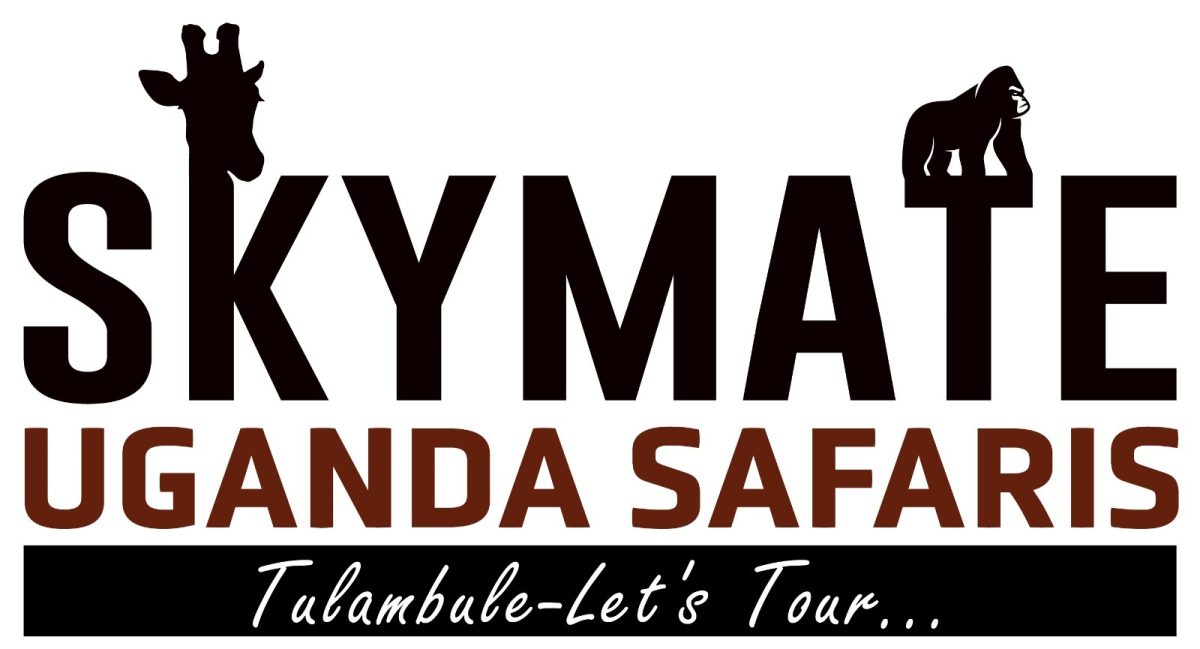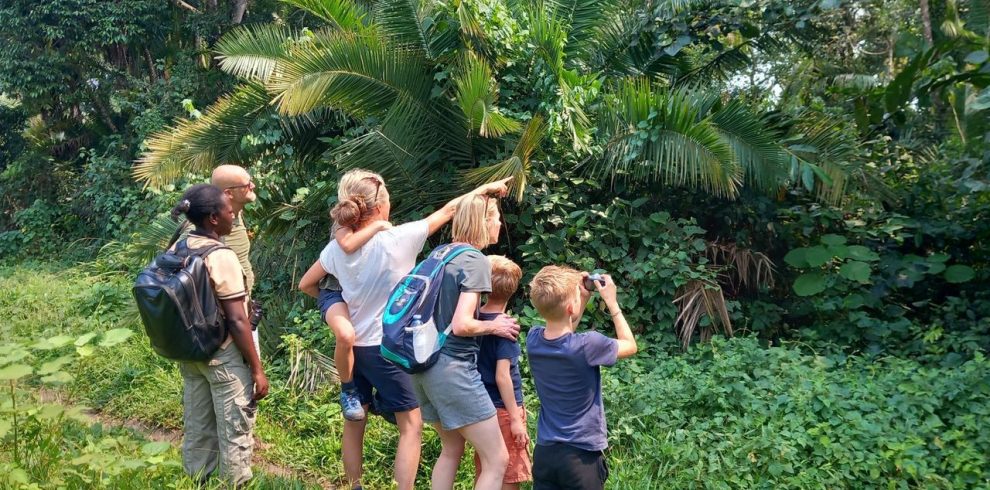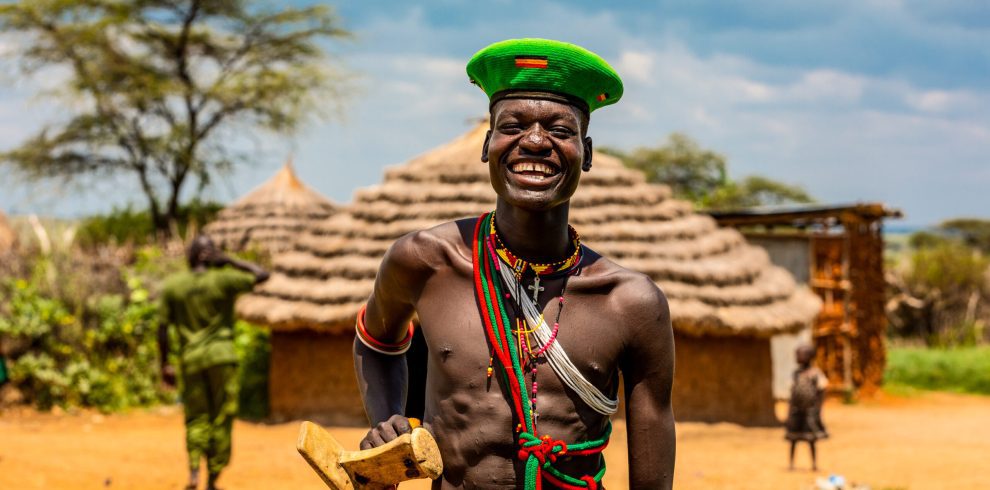This 17 Days Uganda Birding Tour and mammal extravaganza allows you to find the most important birds and primates of Uganda.
The Shoebill stork is almost guaranteed. Over 20 Albertine Rift endemics are also sought, including one of Africa’s most fabulous turacos, Rwenzori Turaco, African Green-breasted Pitta and of course the “must-see” Grauer’s Broadbill.
We also look for other range-restricted Uganda birds, such as Red-faced Barbet. Ross’s Turaco, Great Blue Turaco (almost twice the size of other turacos), and various other birds are virtually garden birds here in Uganda, “the Pearl of Africa”.
Other highlights of our 17 Days Uganda birding tour are a great many primates such as Uganda Red Colobus, Guereza, Mountain Gorilla, and Chimpanzee, not to mention the spectacular scenery, including such famous places as Lake Victoria (Africa’s largest lake), River Nile (the world’s longest river), and Bwindi Impenetrable Forest.
The latter part of this tour is good for a host of more widespread African birds, Lion, Elephants, Buffaloes, Hippos, Crocodiles with some luck Leopard, and fabulous sites such as Murchison Falls, where the mighty Nile is forced through a narrow gap.
17 Days Uganda Birding Tour Summary
Day 1: Arrival in Entebbe and Birding the Shore Of Lake Victoria
Days 2: Shoebill and transfer to Masindi
Day 3: Birding at Budongo Forest’s beautiful Royal Mile, transfer to Murchison Falls.
Days 4: Murchison Falls National Park
Day 6: Murchison Falls to Masindi – Kaniyo Pabidi Forest
Day 7: Masindi to Kibale National Park
Days 8– 9: Kibale National Park/Fort Portal – the Chimpanzee/Green-breasted Pitta combo
Day 10: Kibale to Semuliki National Park and back to Fort Portal
Day 11: Fort Portal to Queen Elizabeth National Park
Day 12: Queen to Bwindi Impenetrable National Park
Days 13: Ruhija, Bwindi Impenetrable Forest
Days 14-15: Buhoma, Bwindi Forest: birds and optional gorilla trekking
Day 16: Bwindi to Lake Mburo National Park
Day 17: Lake Mburo to Entebbe and Departure
17 Days Uganda Birding Tour Details
Day 1: Arrival in Entebbe and Birding the Shore Of Lake Victoria
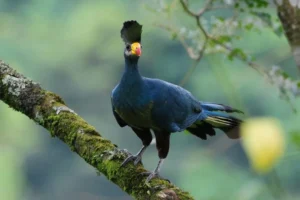
We will pick you from Entebbe International Airport and transfer to a nearby guest house before starting the birding. The striking Double-toothed Barbet as well as the dazzling Black-headed Gonolek are both common around Entebbe. African Hobby and Bat Hawk are sometimes seen around town.
Palm-nut Vulture, Broad-billed Roller, numerous weavers, and perhaps our first Great Blue Turaco might be seen as we bird the Entebbe Botanical Garden on the shore of Africa’s largest lake.
Overnight: The Boma, or similar, Entebbe
Meal Plan: Dinner
Days 2: Shoebill and transfer to Masindi
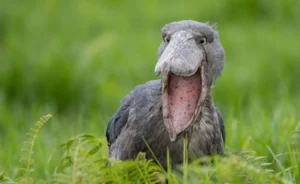
Our day will start with an early breakfast in the hotel. After that, we will visit the legendary Mabamba Swamp, about an hour drive to the north.
This 16,500-hectare wetland on the shores of Lake Victoria is a Ramsar Wetland of International Importance.
It is also Africa’s most accessible site for the Shoebill, Uganda’s most famous and iconic bird. This prehistoric-looking bird is very high on most world birders’ wish list, and for good reason. It is just so different, with a huge, yellow, human-like eyes and that massive bill that looks like a shoe.
We will also search for the papyrus-swamp-loving Red-chested Sunbird, many weaver species that build their impressively neat nests in the wetlands, coucals, and many tropical waterbirds such as Lesser Jacana as we do a dugout canoe trip into the huge swamp. Swamp Flycatchers are also abundant here.
After seeing Shoebill, we will embark on a drive of about 5 hour northwest. We will stop for lunch enroute before reaching our destination, Masindi town, in the late afternoon. Masindi is a pleasant rural town known for being a good stopover on the way to Murchison Falls National Park, where we will go tomorrow.
We will rest, enjoy a delicious dinner and stay overnight at our comfortable lodge after a great first day in Uganda.
Day 3: Birding at Budongo Forest’s beautiful Royal Mile, transfer to Murchison Falls.

Budongo Forest is exceptional for many special birds. Chestnut-capped Flycatcher is a star bird. There is also a trio of small warbler-like flycatchers that are taxonomically enigmatic. Fraser’s Forest Flycatcher is another prized bird in Budongo.
But it is the kingfishers (most of them not associated with water!) that make the Budongo Royal Mile famous. Chocolate-backed Kingfisher is possibly the most popular of them all, but then African Dwarf Kingfisher, Blue-breasted Kingfisher, and others are also completely dazzling.
Fire-crested Alethe, Red-tailed Ant Thrush, and Nahan’s Partridge typically stay close to the forest floor. The pretty Rufous-crowned Eremomela, White-thighed Hornbill, and a lot of others live in the canopy. Fantastic forest barbets, woodpeckers and tinkerbirds abound.
There are a great many greenbuls species that inhabit different levels of the forest from the undergrowth to the canopy, and these are fun to learn to identify.
The Royal Mile is a awesomely beautiful forest to spend time in and surely boasts an extremely rich birdlife. From here we will transfer to Murchison Falls, Uganda’s largest and oldest national park.
Overnight: Murchison River Lodge or Similar
Meal Plan: Breakfast, Lunch & Dinner
Days 4: Murchison Falls National Park

We will enjoy a boat cruise to the bottom of the falls and birding/game drives in this area, where we always add a great many new birds to our list. This is also an excellent place for big and small mammals that might include Giraffes, Elephants, Buffalos, Lions, Leopards, Oribi, Hartebeests, Warthogs, Waterbucks, the rare Patas Monkeys, and many others.
Silverbird, Speckle-fronted Weaver, Black-headed Lapwing, Abyssinian Ground Hornbill, Red-throated Bee-eater, Rock Pratincole, White-headed Barbet, Swallow-tailed Bee-eater, Black-billed Barbet, Meyer’s Parrot, and Bateleur are just a few of the 451 species on our birding menu.
We should of course mention the fact that the massive volume of the Nile River is forced through a narrow gap of 8 meters before plunging 45 meters below to create the Murchison Falls – the world’s strongest waterfall.
While looking at this site there is a small chance that we might also manage to find Pel’s Fishing Owl or Bat Hawk. If possible we can plan a night drive for some nightjar and owl species in the area; these may include Long-tailed, Plain, and Pennant-winged Nightjars and possibly Greyish Eagle-Owl.
Overnight: Murchison River Lodge or Similar
Meal Plan: Breakfast, Lunch & Dinner
Day 6: Murchison Falls to Masindi – Kaniyo Pabidi Forest
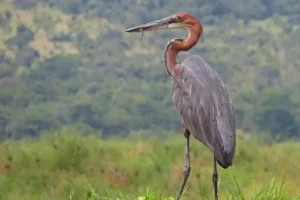
Our will start with an early breakfast and then we are off for a thrilling boat cruise to the delta area in the park! The boat will take us on the legendary Nile River’s more relaxed waters as it joins the Albert delta.
This offers another chance for us to find the iconic Shoebill, along with other special species like Pel’s Fishing Owl, Long-toed Lapwing, Saddle-billed Stork, Red-throated Bee-Eater, Western Banded Snake Eagle, Goliath Heron and African Darter.
We will also see many Hippos in the water, as well as Elephants and Crocodiles on the water’s edge. We end our boat trip at the confluence of the Victoria and Albert Nile. It’s at this point the Victoria Nile flows south into Lake Albert and the Nile continues into South Sudan and eventually to Mediterranean Sea in Egypt.
After our early morning boat tour we will have some game drives. We will enjoy a packed picnic lunch somewhere on the banks of the Nile. Our drive will also take us to an iconic spot: the top of the Murchison Falls. After this exciting day we’ll drive back to Masindi.
If there is time we’ll make a brief stop in the Kaniyo Pabidi section of the Budongo Forest along the way to look for the Puvel’s Illadopsis, (as it is the only known East African site for this rare forest dweller) as well as other lowland forest specials such as Western Crested Guineafowl, Spotted Greenbul, African Dwarf Kingfisher, Blue-breasted Kingfisher, Forest Robin and Yellow-mantled Weaver.
We will then proceed to the guesthouse where we stayed two nights ago. We will have dinner and some time to relax before falling asleep after a busy birding day!
Overnight:
Meal Plan: Breakfast, Lunch & Dinner
Day 7: Masindi to Kibale National Park
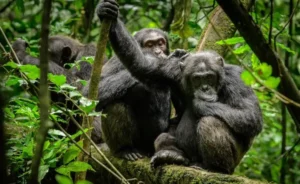
We start the day with a good breakfast. We will then take a very scenic drive south to the Albertine Rift area.
The drive is about 5 to 6 hours long, but the time will fly by; it’s just so beautiful here! We will reach Fort Portal town at around lunchtime.
The fort that gave the town its name might not stand anymore, but this is a beautiful town in another scenic area of Uganda.
We will enjoy lunch at one of best restaurants in town. After lunch we’ll transfer to Kibale Forest National Park, about an hour to the south.
Overnight: Kibale Forest Lodge or Similar
Meal Plan: Breakfast, Lunch & Dinner
Days 8– 9: Kibale National Park/Fort Portal – the Chimpanzee/Green-breasted Pitta combo
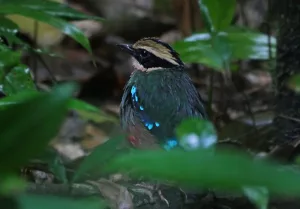
Our main avian target will be Green-breasted Pitta, which is best found at dawn, when its display call allows us to narrow down its whereabouts (otherwise, despite the jewel-like colors of this bird, it’s like looking for a needle in a haystack on the forest floor). While we search for this bird the atmospheric, quite scary noises of large troops of Chimpanzees resonate through the forest.
There is also the chance for optionally trekking for Chimpanzees. We should also find some other primates such as Uganda Red Colobus, Blue monkeys, Black-and-white Colobus, Red-tailed Monkey, and other monkeys (not to mention the well-built Olive Baboon, which wanders around in massive groups, usually on the ground).
We also have a lot of good birds to see, which might include Narrow-tailed Starling, Black-billed Turaco, White-headed Wood Hoopoe, and Chestnut Wattle-eye.
Overnight: Kibale Forest Lodge or Similar
Meal Plan: Breakfast, Lunch & Dinner
Day 10: Kibale to Semuliki National Park and back to Fort Portal
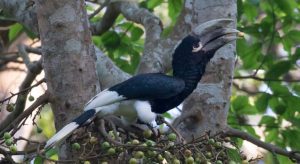
After an early breakfast, we’ll grab our binoculars and head west to a very special park. We are going to have a full birding day in Semuliki National Park. It is a 2 hour drive with incredibly scenic views along the way.
The Semuliki’s forest is a continuation of West African jungle that stretches all the way from Equatorial Guinea through Congo, forming a habitat for some special Guinea-Congo biome species that do not exist in other areas of east Africa.
The 219 km2 forest park is contiguous with the DR Congo’s great Ituri forest. It is one of the richest areas of floral and faunal diversity in Africa, especially for bird species.
The park is also known for its primordial hot springs, and you will feel a change in the air as we walk along the trail network looking for birds today. It is the closest you can get to central Africa’s steaming jungles from anywhere in east Africa. Over 440 species of birds have been recorded in the park, of which 50 are found nowhere else in east Africa!
We will look for Guinea-Congo biome specials and others like Congo Serpent Eagle, Oberländer’s Ground Thrush, Nkulengu Rail, Spot-breasted Ibis, Long-tailed Hawk, Red-rumped Tinkerbird, Lyre-tailed Honeyguide, Crested Malimbe, Swamp Palm Bulbul, Blue-billed Malimbe, Pale-fronted Nigrita, Piping, Black Dwarf, Red-billed Dwarf Hornbill and African Piculet.
After our amazing day in this very special patch of forest we will drive back to our hotel in Fort Portal for relaxation, dinner and overnight.
Day 11: Fort Portal to Queen Elizabeth National Park
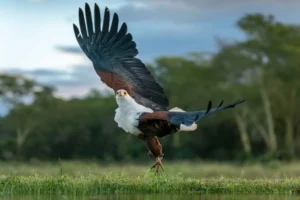
We will have a leisurely breakfast today, before we depart and head south to Queen Elizabeth National Park. It is a drive of approximately 2 to 3 hours, depending on how many stops we make along the way to spot some more birds.
We’ll arrive at our lodge in time for lunch. After lunch, we will have a short game drive. England’s queen officially opened this park (well-known for its tree-climbing lions and boasting 100 mammal species and 612 bird species!) in 1954.
One of the highlights of our stay here is getting out on the Kazinga Channel by boat and seeing crocodiles, Hippos, and a great many waterbirds. Naturally we also see Warthog, Buffalo, Uganda Kob, and a plethora of other mammals. Forest Hog usually steals the show, however.
Day 12: Queen to Bwindi Impenetrable National Park

After an early breakfast, we will depart “Queen” and head even further south.
Before leaving the park we ‘ll undertake a game drive in the Ishasha sector in the Rukungiri District in search of the famous tree climbing Lions, whose males sport black manes that tend to lie on fig tree branches scanning the plains for prey.
We will enjoy lunch somewhere along the route as we continue to Africa’s richest forest for primates and birds, Bwindi Impenetrable National Park, and stay in its high-altitude Sector of Ruhija.
Overnight: Gorilla Forest Camp or Similar
Meal Plan: Breakfast, Lunch & Dinner
Days 13: Ruhija, Bwindi Impenetrable Forest
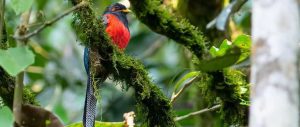
We’ll start birding the forest-covered hills of Ruhija, looking for the beautiful Black Bee-eater and also trying to find Grauer’s Swamp Warbler at a roadside site, so that we can reduce the length of the long walk, this warbler occurring right in the lower reaches of Mubwindi Swamp. Mountain Yellow Warbler might also be seen, nice to compare with Papyrus Yellow Warbler.
A walk most of the way down to this swamp can’t be avoided, though, as Grauer’s Broadbill, one of Africa’s most desirable birds, also occurs there.
The good-looking, highly localized Yellow-eyed Black Flycatcher also lurks pretty close to the bottom reaches. The walk down to the site for this broadbill (and back) takes a large part of the day, but this is one of the best birding days of the entire tour.
Trip participants typically end up getting a constant stream of life-birds through the day, mainly Albertine Rift endemics. Banded Prinia, Mountain Masked Apalis, Rwenzori Apalis, Chestnut-throated Apalis, the strange-looking Grey-throated Barbet, Red-faced Woodland Warbler, and up to 4 species of brightly colored forest finches known as crimsonwings are often encountered.
There are too many high-quality species to list here, but we hope to find Olive-breasted Greenbul (one of the more attractively colored greenbuls.
We do need to mention a couple of the other range-restricted species as well, though, – the very long-tailed Blue-headed Sunbird, the dazzling Regal Sunbird, Stripe-breasted Tit, Rwenzori Batis, and also slightly more widespread species like the fabulous Bar-tailed Trogon and Rwenzori Hill Babbler.
Overnight: Gorilla Forest Camp or Similar
Meal Plan: Breakfast, Lunch & Dinner
Days 14-15: Buhoma, Bwindi Forest: birds and optional gorilla trekking
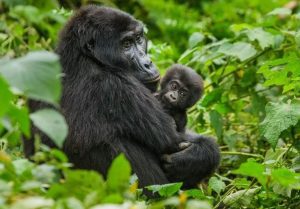
Along the way between the higher-altitude Ruhija and the lower-elevation Buhoma sections of the park we stop to bird “The Neck”, which allows us to see quite a number of species we won’t find elsewhere. Black Bee-eater, Chubb’s Cisticola, Cinnamon-chested Bee-eater are both quite easy to see here.
Black-and-white Shrike-flycatcher might be seen – this charismatic bird usually moves around a lot and makes lots of noise as it flies around from one perch to the next. It has a fabulous crest, but the female is chestnut and white, whereas the male is black-and-white with striking yellow eyes.
We might also see Mackinnon’s Shrike, Brown-throated Wattle-eye, Bronzy Sunbird and several other sunbirds, African Grey Woodpecker and Augur Buzzard.
Deep-forest birds we’ll seek include many more localized endemics that barely get into neighboring countries – Grauer’s Warbler, Bar-tailed Trogon, Petit’s Cuckooshrike, Lühder’s Bushshrike, Brown-capped Weaver and Red-throated Alethe.
We’ll be sure to spend time looking for slightly more widespread birds as well, including the skulking White-spotted Flufftail, Red-shouldered Cuckooshrike, Olive-bellied Sunbird, some beautiful forest barbets such as the large Yellow-billed Barbet, the dazzlingly bright and shiny, green-and-yellow African Emerald Cuckoo, and, last but not least, Black-billed Turaco.
Forest-edge birding can be equally rewarding (and often easier for photography!) with such specials as Dusky Long-tailed Cuckoo, Great Blue and Ross’s Turaco, Black-necked Weaver, Northern Double-collared Sunbird, and Grey-headed Nigrita. Over our two full days here we will spend plenty of time birding the forest trails, forest edge and adjacent agricultural areas.
At Buhoma itself, there is the chance for one day optionally gorilla trekking.
Overnight: Haven Lodge Buhoma or Similar
Meal Plan: Breakfast, Lunch & Dinner
Day 16: Bwindi to Lake Mburo National Park
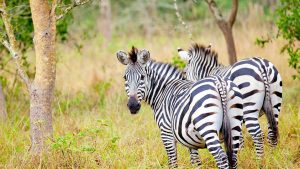
After an early breakfast, we will head northeast towards our final park of this fantastic 17 Days Uganda birding tour, Lake Mburo National Park. The drive to the northeast will take about 5 hours, but we will still look for birds, and make rest stops as needed.
We will enter the Lake Mburo National Park through the Sanga Gate. Just outside the park we will come across some of the world-famous long-horned Ankole cattle of the Bahima people that live in the area – always a highlight and worthy of a few photos.
We eventually arrive at Lake Mburo National Park (where we’ll spend two nights), which breaks the journey between Entebbe and Bwindi. Lake Mburo is home to over 300 bird species and 68 species of mammals.
We will reach our lodge and check in, followed by a superb late lunch. We will end our day with an afternoon/early evening game drive in the park.
Overnight: Rwakobo Rock or Similar
Meal Plan: Breakfast, Lunch & Dinner
Day 17: Lake Mburo to Entebbe and Departure
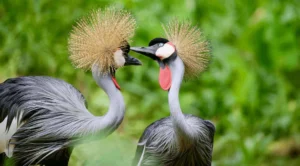
Today, we will take a boat cruise on the lake, and this is one of the easiest places to find African Finfoot.
We sometimes see overwintering Malagasy Pond Heron and Papyrus Gonolek in addition to an array of kingfishers including the likes of Malachite Kingfisher, Giant Kingfisher, Pied Kingfisher, and the rare Shining-blue Kingfisher.
In general this park gives us an excellent opportunity to see a lot of arid-country birds, which can include Blue-naped Mousebird, Bare-faced Go-away-bird, and the incredibly localized, rather “thin-on-the-ground” Red-faced Barbet, along with a more widespread East African species, Spot-flanked Barbet.
Nubian Woodpecker is often heard before it is seen. Like in most arid-habitat parks in East Africa a large bird list can be accumulated very fast, and the above species are just a few of the many goodies we expect to find.
This is the only place where we’re likely to see Plains Zebra during our Uganda birding tour, and there are a lot of other mammals as well, such as Hippopotamus, African Buffalo, Defassa Waterbuck, Bohor Reedbuck, Topi, and Common Eland.
After the boat cruise we will embark on the transfer to Entebbe, about 4 to 5 hours away.
We will make a photo stop at the Ugandan Equator crossing at Kayabwe, where you can stand with one leg in the Northern hemisphere while the other remains in the Southern! It is also an impressive site for buying souvenirs to take back home as a memento of this incredible 17 days Uganda birding tour.
